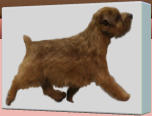

Breeders Corner

Kafka said, "All knowledge, the
totality of all questions and
answers, is contained in the dog."

Please submit your article,
publication or hyperlink to an
article to Judi Hartell.
DataDawg@Austin.rr.com
Submissions

Quote



The Bluebonnet Norfolk Terrier Club does not recommend,
guarantee, endorse, nor rate these recommendations or
contributors, their kennel or their stock. The purpose of this section
is to share the knowledge and experience of breeders who have vast
experience in whelping and raising puppies. The tips and tricks
below are intended to augment qualified veterinarian care, not as a
substitute for qualified veterinarian care of the dam and puppies.






POLYGENIC
These traits are more complex than the typical dominant or recessive genetic trait. The
additive interaction of the genes can cause variable results and the gene can be easily
passed on to other generations without being identified.
Canine hip dysplasia and elbow dysplasia are believed to be polygenic defects.
1. As with the recessive trait, both the sire and the dam must contribute one or more of
the genes that cause the abnormal phenotype in the offspring.
2. Unlike recessive traits, the contribution from the sire and dam need not to be equal.
3. Since we do not know the number or the specific effect of the genes involved in
polygenic traits in dogs, no predictable Mendelian ratios are associated with these traits.
4. Both sexes are affected with polygenic traits (excluding sex-limited traits), but not
necessarily in equal numbers.
5. The trait may skip generations and may appear to be erratic in occurrence.
Especially when it comes to polygenic defects it is hard to tell which one of the parents is
mainly responsible for the defect in part of the offspring. It is throughout possible that
the bitch and the sire are equally responsible, but it could be that the bitch’s part is 99,5%
and the sire’s part is 0,5%, or the other way around. A breeder might exclude both
animals from the breeding stock, but this could mean that he would exclude a valuable
animal that would produce normal puppies if mated to another partner.
Homozygous & Heterozygous Genes.
Heterozygous gene pair example: Tt (members are dissimilar)
Homozygous gene pair examples: TT and tt (members are alike)
Breeders goal: To "arrange" good genes in homozygous pairs to ensure that no matter
which member of a gene pair a parent happens to pass on to a puppy, it will be a
"desirable" gene.


- Behavior
- Honor Roll
- Living With Norfolk Terriers
- Fun With Your Norfolk
- Tip Of The Week
- Publications
- Therapy and Service Dogs
- Health & Nutrition
- Competition


- Books
- Clubs
- Collectibles, Gifts & Fun Activities
- Companion Animal Recovery
- Dog Show Superintendents
- Genetics
- Health Related Sites
- Canine Health Links
- Vaccination Protocols
- Animal Health Trust
- Online Mendelian Inheritance In Animals
- Univ. Of Cambridge Vet. School
- Canine Inherited Disorders Database
- All Creatures Veterinary Hospital
- A First Aid Kit
- Veterinary Pet Insurance
- AKC Pet Health Plan
- Cornell Univ. College of Vet. Medicine
- More Health Related Sites
- Independent Sites
- Pet Travel
- Training Your Puppy
- Publications


- Breeding Tips
- Breeding Tips Page One
- Breeding Tips Page Two
- Breeding Tips Page Three
- Breeding Tips Page Four
- Breeding Tips Page Five
- Breeding Tips Page Six
- Virus &The Pregnant Bitch
- Dog Neutering Video
- Vaccinations & The Pregnant Bitch
- Incontinence In The Pregnant Bitch
- Flagyl & The Pregnant Bitch
- Canine Reproduction
- Frozen vs Chilled Semen
- Modern Breeding Management
- Dialogue On Rasberry Leaves
- Monitoring Pregnancy
- Uses For Vaginal Cultures
- OFA & The Pregnant Bitch
- Breeding Tips Page Seven
- Breeding Tips Page Eight
- Breeding Tips Page Nine
- Breeding Tips Page Ten
- Breeding Tips Page Eleven
- Breeding Tips Page Twelve
- Breeding Tips Page Thirteen
- Breeding Tips Page Fourteen
- Genetics And Inheritance
- Rescue









